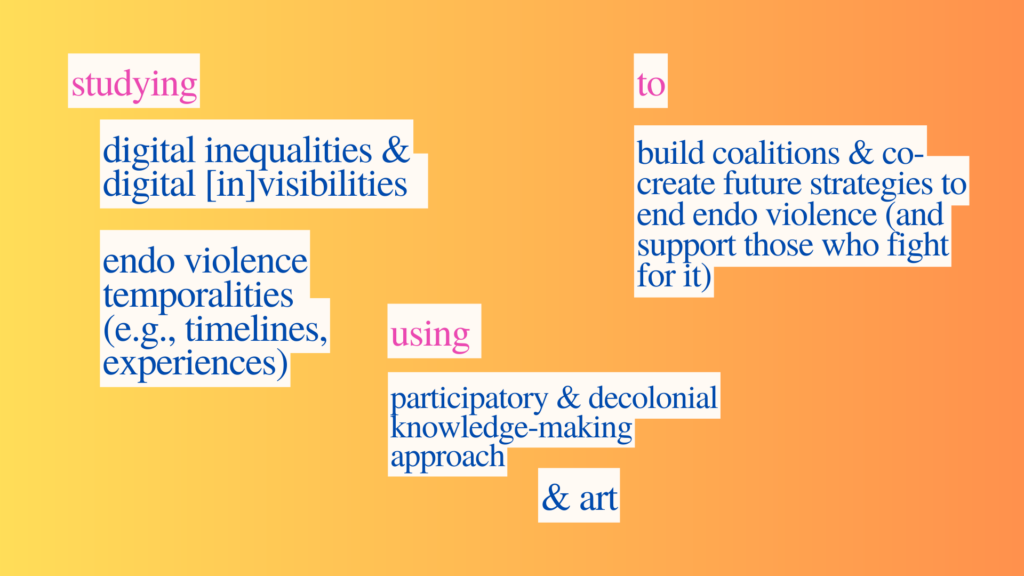research, artivism, & coalition building – led by dr Alicja Pawluczuk [ @HY_STERA ]
introduction
This research project aims to examine the interplay between endometriosis-related violence (defined here as endo violence) temporalities and digital [in]equalities. Using participatory and decolonial knowledge-making approaches (Lugones, 2010), the objective is to gain insight into how those affected by endometriosis experience resist and fight against instances of endo-violence (e.g., medical misogyny, social stigma around menstruation) using digital technologies.
This project is framed within the broader context of the INCLUDE+ Network, examining the impact of digital [in]equity on well-being, civic participation, and precarity.
This project is broadly guided by the following objectives:
- Co-investigate the temporal dimensions and manifestations of endometriosis-related violence (endo-violence) among people affected by endometriosis;
- Examine the ways in which digital inequalities affect personal and collective digital [in]visibilities within endometriosis communities;
- Explore possible pathways for coalition-building, aiming to generate future support strategies.

endo Violence refers to the systemic and structural injustices resulting in health, social, economic, and digital inequalities of those affected by endometriosis. It encompasses a wide range of harmful practices, attitudes, and behaviours that violate the rights and dignity of individuals seeking support, and services.
temporality
noun
noun: temporality; plural noun: temporalities
1.
the state of existing within or having some relationship with time.
"like spatial position, temporality is an intrinsic property of the object"
endo violence temporalities refer to the different experiences of times related to individuals and collective endometriosis experience (e.g., someone’s first symptoms or their first period; the time being told that their pain is normal; their waiting time for their diagnosis, the time it takes them to recover after each endometriosis flare-up)
endometriosis
Endometriosis is a disease in which tissue similar to the lining of the uterus grows outside the uterus. The cause of endometriosis is unknown. There is no known way to prevent endometriosis. There is no cure, but its symptoms can be treated with medicines or, in some cases, surgery. Endometriosis affects 1 in 10 people assigned females at birth (it is rare in individuals assigned male at birth). Although existing data suggest that that affects approximately 1 in 10 women, there is no existing data to show the numbers of transgender, genderfluid, and non-binary people (Holowka, 2022). It is estimated that worldwide 176 million people have ‘endo’ (WHO, 2023). Endometriosis symptoms are often dismissed as “bad cramps”, which leads to an average of 10 years delay in diagnosis.
You can learn more about endometriosis here.
crip time & endo violence temporalities
The notion of Crip Time (Kafer, 2013) is used here as a critical lens to explore the relationship between time, marginalisation, and digital [in]visibility.
Crip time helps to examine how endometriosis and disability, and other marginalised identities are rendered invisible in historical accounts and future projections in which disabled bodies are not “permitted to exist as part of desired present or desirable future” (Kafer, 2013: 43). People affected by endometriosis symptoms often fall outside of what is often considered as normative stages of life progressions (e.g. for female bodies this might include getting your first period, getting pregnant, followed by menopause); linear expectations of ‘one’s finally getting better’.
you can read these resaerch as flip note magazine here; for a simple text version click here.
Endo-violence temporalities refer to the different times related to individuals and collective endometriosis experience. Such temporalities might include someone’s first symptoms or their first period; the time being told that their pain is normal; their waiting time for their diagnosis, the time it takes them to recover after each endometriosis flare-up; the time in chronic pain; the time without pain; the waiting time for their surgery; the time bleeding excessively, the times being told that their symptoms are part of their nature or their hysteria.
Endo-violence temporality might include the time preparing oneself for potential harm or discrimination, receiving harm, recovering from it, resisting harm, or organising and fighting against it. In the words of Samuels and Freeman, endo-violence temporality can be seen as, “a time of survival and even of world-making” and co-creation of “strategies for surviving the normative “violences of capitalist time and, in the key of liberation, strategies for inventing new models of work, sociability, and being” (2021:249).
The aim of this project is to specifically focus on organising and fighting against instances of endo-violence using digital technologies. This is to be done by a collective reflection on how endo-violence has been manifested until now, and if/how we can fight for endo-violence-free futures.

what is endo violence?
Endo-Violence refers to the systemic and structural injustices resulting in health, social, economic, and digital inequalities. It encompasses a wide range of harmful practices, attitudes, and behaviours that violate the rights and dignity of individuals seeking support, and services.
Endo Violence[1] refers to a set of beliefs and norms, acts or processes that are harmful or discriminatory towards an individual or group based on their understanding of the intersection of gender with other inequalities/oppressions, (e.g., race, ethnicity, socioeconomic status, age, disability, and immigration status, and many others) (Pawluczuk, 2023).
Endo Violence is deeply connected to racism, classism, colonialism, and ableism. Black women are less likely to be diagnosed with endometriosis (Beogie, 2019). In the case of trans people, doctors may also be quick to blame every symptom on being trans or gender-affirming care (Neufeld & Leggott, 2021).

endo violence magazyn #01
Endo Violence Magazyn #01 is an attempt to introduce people to the initial definition of endo violence and cover some of my personal reflections and motivations behind this research project. My intention is to co-create future editions with the endometriosis community and to use it as a platform for cross-disciplinary and critical conversation (which would not be limited to text but different forms of expression such as photography, poetry, and digital art).
to access endo violence magazyn, please visit this link.
research questions guiding this project
- What can be learned from endometriosis communities about their experiences of endo-violence (e.g., processing, supporting other victims/survivors, calling out, fighting back)?
- What are the different temporalities co-created by endometriosis digital communities (e.g., past, present, imaginary futures) and what are we fighting for/against?
- What can be done to improve the community’s meaningful digital inclusion and visibility?
- Finally, what forms of community support, collective care, and coalition building might help us to co-imagine and co-create endo-violence-free futures?
These exploratory questions aim to provide a starting point for this research project with an aim to identify more specific topics and issues while working with the endometriosis community in participatory settings. In the context of this research project, I’m primarily concerned with how endo-violence temporalities are manifested within digital endometriosis communities and how these intersect with wider digital inequalities.
My intention is to ensure that the sequential steps of this research study are informed by the endometriosis community – while being realistic about the limitations of any participatory research processes and the academic power structures that might affect the knowledge creation process.
references + the works that inform this project
Chazan, M. (2023). Crip Time and Radical Care in/as Artful Politics. Social Sciences, 12(2), 99.
Holowka, E. M. (2022). Mediating pain: navigating endometriosis on social media. Frontiers in Pain Research, 3, 889990.
Kafer, A. (2013). Feminist, queer, crip. Indiana University Press.
Lugones, M. (2010). Toward a decolonial feminism. Hypatia, 25(4), 742-759.
McRuer, R. (2006). Crip theory: Cultural signs of queerness and disability. NYU press.
Samuels, E. (2017). Six ways of looking at crip time. Disability studies quarterly, 37(3).
Samuels, E., & Freeman, E. (2021). Introduction: crip temporalities. South Atlantic Quarterly, 120(2), 245-254.
